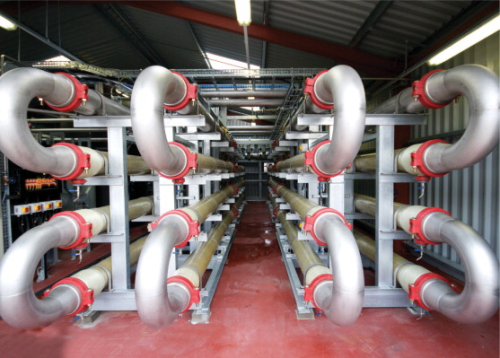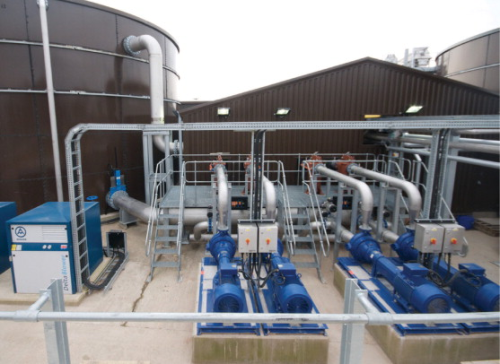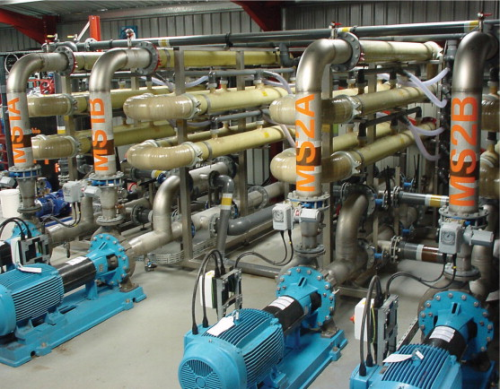


The issues surrounding wastewater recycling in the food and drinks sector are generally well known. In recent years the design and installation of new wastewater reuse plants in this sector has served to build confidence in the safe reuse and reduced the ‘stigma’ of recycling water into food factories. The main issues are now linked to the economics of recycling water in times of rising incoming water charges and outgoing effluent disposal costs, plus limitations on borehole/surface water extraction or final discharge constraints. Users with an incoming mains water supply are charged for both potable water into the factory and trade effluent out of it.
Recycling is therefore an increasingly attractive option. With recent developments in treatment technology the ‘payback’ on capital investment has reduced significantly, in many cases to less than two years. These ‘motivating’ factors are exacerbated by business growth and/or factory expansion, corporate pressure from customers to reduce carbon footprint or improvement of environmental ‘credentials’. Abstraction is also affected by more global concerns such as decreasing ground water levels caused by a higher general demand for water and/or climate changes. Companies that already have an existing wastewater pre-treatment infrastructure in place may well find the investment for potable recycling option more attractive.
Aquabio has specialised in industrial water reuse since 1998 and uses its own crossflow membrane bioreactors (MBRs) as the ‘core’ process in wastewater recycling plants. The MBR plants have ‘true’ ultrafiltration (UF) membranes mounted outside of the bioreactor in dry conditions which means hygienic operation, ease of maintenance and no parts immersed in the biomass.
The company has developed three types of system. These include the AMBR™, which utilises high crossflow to achieve high flux rates. The bioreactor can be operated at high biomass suspended solids concentrations (MLSS). The technology is aimed at lower flow and higher strength wastewaters. Plants are extremely compact, with very low membrane area and low membrane replacement costs. The membrane banks are operated automatically based on levels in the bioreactor and hence are utilised, as required, to match the inlet flow. When not required individual membrane banks are automatically shutdown, auto-flushed to remove biomass and await re-start thus saving energy when the plant is not running at full design capacity, or when membrane flux is higher than design. AMBR™ plants are modular, can be containerised and are relatively low in capital investment cost.
The AMBR LE™ utilises intermittent backflushing for the control of membrane fouling and hence allows a reduction in crossflow velocity and a significant saving in energy. Medium to high MLSS concentrations are accommodated and AMBR LE™ is aimed at medium to high flow and low to high strength wastewater. With variable speed recirculation pumps the system allows for a ‘managed’ flux rate which is used to optimise energy consumption relative to the plant load. Plants remain very compact, with low membrane area and moderate membrane replacement costs. Plants also operate on a direct link to level in the bioreactor, automatically adjusting membrane permeate production (and energy use) to suit the inlet flow conditions. AMBR LE™ is particularly suited to applications with inconsistent or variable wastewater flows, high peak or seasonal loads, or when electricity costs are moderate to high.
BIOVERT® incorporates vertically mounted modules and uses air injection to reduce further energy consumption. This process allows for medium MLSS concentrations and is aimed at higher flows and low to medium strength (i.e. mainly larger municipal applications). Plants are compact, with vertically mounted membrane modules and have more installed membrane area. Plants operate on a more constant level in the bioreactor, with controlled air injection at either the top, or the bottom, of the membrane tubes. Air scour and turbulence reduces surface fouling and energy use is very low. BIOVERT® plants are particularly suited to applications with large consistent wastewater flows and when electricity costs are high.
Kanes Foods
In 2001 Kanes Foods in Evesham, UK installed an Aquabio ‘first generation’ AMBR™ plant combined with reverse osmosis and UV disinfection for wastewater reuse at potable water standards. On the initiative of the company's owner Dr John Randall, and extensive trial work over the preceding 18 months, this became the first food plant in Europe to recycle treated wastewater on a large scale producing high quality, potable water. Due to factory growth and continuing limitations on water supply and discharge options, Kanes has recently installed a second AMBR LE™ plant on the same site to increase the treatment capacity and recycle volume.
The 2001 ‘first generation’ AMBR™ process treatment scheme comprises upstream screening, flow balancing, dissolved air flotation (DAF) treatment for fine vegetable solids removal, the AMBR™ itself and downstream treatment by reverse osmosis followed by UV disinfection. This process yields potable quality water suitable for blending with mains water for use within the factory.
The process comprises two 250m3 bioreactors with four banks of crossflow membrane modules. The maximum biomass solids (MLSS) concentration employed has been as high as 22g/L, but the bioreactor is generally operated at around 10g/litre. Sludge production is calculated as being 0.14 kg DS/kg COD removed at a sludge age of over 100 days.
| Parameter | Original plant | New plant | Combined |
| Volume to screening/balancing | 1.200 MLD | 2.250 MLD | 2.250 MLD |
| COD concentration (average) | 1,000 mg/L | 1,000 mg/L | 1,000 mg/L |
| Volume to DAF system | 0.815 MLD | 1.435 MLC | 2.250 MLD |
| Volume to MBR process | 0.815 MLD | 1.435 MLD | 2.250 MLD |
| Volume to RO system | 0.815 MLD | 0.858 MLD | 1.673 MLD |
| Volume of potable quality water for re-use | 0.650 MLD | 0.600 MLD | 1.250 MLD |
| Process stage | Original plant | New plant |
| Preliminary screening | Old screen now redundant | Rotary drum screen, 220 m³/hr, 0.7 mm |
| Balancing | Old 900 m³/hr balance tank now used for outlet balancing | 1640 m³ balance tank c/w mixing/aeration |
| DAF treatment | DAF system, 50 m³/hr | DAF system, 60 m³/hr |
| Secondary screening | Backflushing filter/screen, 0.5 mm | Rotary drum screen, 80 m³/hr, 0.25 mm |
| Biological treatment | 2 No. 250 m³ bioreactors c/w jet mixing/aeration | 1 No. 765 m³ bioreactor c/w slot mixing/aeration |
| UF membrane separation | 4 No. membrane banks, 34 m³/hr | 4 No. membrane banks, 60 m³/hr |
| Reverse osmosis | RO system, 27 m³/hr | RO system, 25 m³/hr |
| UV disinfection | UV disinfection unit, 27 m³/hr | UV disinfection unit, 25 m³/hr |
| Sludge handling | 22 m³ sludge tank | 50 m³ sludge tank |
Each membrane bank (see Figure 1) comprises four UF membranes. The membranes operate at an average flux of 153 litres permeate production/m2 membrane area (LMH) normalised to 25°C. The permeate water has average TSS, BOD and COD concentrations of only 4, 7 and 16 mg/L respectively.
The UF permeate then passes to a two-stage reverse osmosis plant which achieves an overall recovery of 75%. The reject stream is discharged to sewer and the permeate, which typically has a conductivity of 40–100 μS/cm, is passed to the UV disinfection unit and on to the client's water supply tank.
Old plant performance
The plant has now been in continuous operation for nine years and has performed consistently in terms of biological treatment, membrane performance and final reuse water quality. For the majority of the time membrane performance has been better than design allowing one bank to be maintained as a standby and so offering more process flexibility and lower energy use. Occasional reductions in membrane flux have been linked to poor biomass health which has been rectified by closer management of the process.
Latest developments with AMBR LE
Due to continued production expansion and the consequent pressure on incoming water supply and discharge consent, a second wastewater treatment plant was constructed by Aquabio and commissioned in February 2010. This new plant provides an additional 1.435 megalitres (MLD) of biological/MBR treatment capacity and an additional 0.6 MLD of re-use water (see Table 1). The plant replicates the successful process scheme of the existing plant (see Table 2) but utilises Aquabio's AMBR LE™ technology to provide significant energy savings compared to the original plant. New common inlet screening and flow balancing facilities are provided, which allows the original balance tank to be used to balance outgoing flows to sewer. Again, DAF treatment is employed to remove fine vegetable solids prior to the AMBR LE™ system. A single bioreactor of 765m3, allowing for MLSS concentrations up to 12 g/L, is aerated by a blower assisted slot type aeration system, with high alpha factor characteristics.
The AMBR LE™ UF membrane system comprises four banks of 4m long membranes. Low energy performance is achieved by the use of backflushing to control membrane fouling thus allowing much reduced cross flow velocities and hence significantly lower energy use. The combination of backflushing frequency and variable cross flow velocity is optimised to give the lowest energy use for the required throughput. Significant process flexibility is offered by the inclusion of variable speed recirculation pumps and optional permeate pumping to control the membrane trans-membrane pressure (TMP) and hence the flux performance. Stable performance is currently being achieved at an energy use of 0.3–0.5kWh per m3 of treated permeate for the biomass separation, a significant improvement on the original plant. By the end of March 2010 both Aquabio plants had recycled a total of 1.68 billion litres (3.7 billion Imperial Gallons) of potable quality water back into the factory since their start up. Additional quantities of AMBR™ permeate water have also been reused in non potable duties.
Conclusions
With ever increasing water costs to, and pressures on, food and drinks production, tightening water extraction, discharge limitations and developments in treatment technology, water recycling has become a high priority subject for most medium to large scale food and drinks producers around the world. Established full scale reference plants, some of which have been operating reliably for nearly ten years, have resulted in greater public confidence in safe potable water reuse. •






